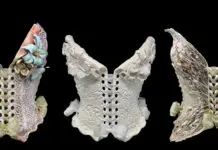“Our Mennonite church got chased out of Arkansas by the mosquitoes in 1911,” says Bill Chupp. “So it’s celebrating its 100-year anniversary here.”
Chupp, owner and operator of Chupp Implement Company, is a longtime resident of the Chouteau-Pryor area, which is home to one of Oklahoma’s scarce Amish and Mennonite settlements. Residents agree that he is the be-all, end-all of sources for local lore. Chupp’s family settled in Chouteau after leaving Kansas in 1929, and he is steeped in local history and culture.
Although Oklahoma has relatively small Amish and Mennonite populations, members of the religious cultures have been growing. In the past 20 years, the Amish church alone in the Chouteau area has expanded to encompass four separate houses, where services are held for some 20 families in each. Every other Sunday, “bench wagons” load up portable benches for church members and set up in delegated homes. On Sundays when there is not service between Easter and Thanksgiving, members share a single Sunday school location.
According to Chupp, the first members of the Amish church in Mayes County mostly traveled from Ohio and Indiana to settle in Mazie, Okla., before an epidemic forced them to move to nearby Chouteau. Farming was done by horse and steel-wheeled tractors only, although recent years have seen the advent of rubber tires locally.
When asking about town, one can still hear the family names of the original settlers: Yoder, Coblentz, Detweiler. Low German is still spoken by many members of the community, who learn such skills as carpentry, mechanics and furniture craftsmanship from older generations.
While recent years have seen many younger generations of Amish convert to the Mennonite faith – in part due to the Mennonites’ more tolerant perspective on technology – members of the two cultures co-exist harmoniously here. They share religious roots in the Anabaptist movement, but small yet crucial differences separate the churches. In the Chouteau area, many families have members belonging to both sects.
Although members of these communities may live quietly separated from much of modern society, they often can be found lending a helping hand anywhere in the world. Each fall, the Mennonite Central Community meets in Enid for its Oklahoma Mennonite Relief Sale. Homemade ice cream, furniture, noodles, pies and more are sold to raise almost $100,000 in charitable funds. In addition, members of the church have canned some 17,000 pounds of meat for relief in disaster-stricken countries such as Haiti, and this past spring, several members of Chouteau’s Amish church traveled to Tuscaloosa, Ala., to assist with tornado relief efforts.
“It’s a very benevolent group of people,” says Chupp, who himself has traveled to more than 40 countries, and has visited other Amish communities in such unlikely places as Brazil.
But while Amish and Mennonite communities may also be found across the globe, they have definitely become an indelible part of Oklahoma history and culture.
“These people are true citizens of this area,” says Chouteau Mayor Jerry Floyd. “They get involved in most town functions, such as the Black Buggy Days, with their concession stands and their rodeos. The Amish Cheese House and the Dutch Pantry bring in a lot of travelers and tour buses; they all stop by on their way through town. Some of the Amish cater dinners at their homes, which bring in out-of-towners.
“As a whole I feel that they are a great asset to the town and surrounding areas.”


























